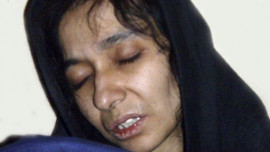
At a seminar held on Thursday, Dr Sarah Ansari, who heads the department of History at Royal Holloway, the University of London, spoke on Sindhi nationalism. The professor took the audience through her research on the complexities of the phenomenon, including the peculiar relationship between Sind(h) and Bombay, as well as Hindu and Muslim identity in the province.
For starters, Dr Ansari went about dispelling a few myths, one of which is that Karachi was a small fishing port of no great importance to the British Raj and it only gained importance after Independence. Actually, Sindhi ports became a training ground for British civil servants who not only learnt the administrative ropes but were also schooled in how to deal with the local people. Among other things, this meant that for the officers, Sind was a nursery where they came to understand the working relationship between Hindus and Muslims.
But of course, none of that is ever whispered outside the hallways of academia. And parts of post-partition history seems to gloss over the Hindu contribution to the formation of a Sindhi identity as a whole.
So why were Hindu interests ushered to one side?
It seems that a strange phenomenon developed after partition; a ‘Muslim’ fever eclipsed the knowledge that the state was built to serve a once minority (i.e. Muslims in India). The problem with Sindhi nationalism in this regard is two-fold. The first is that in order to gain any prominence one must gain the support of the people, which in light of the creation of a Muslim republic could only be done under the banner of those who believed only in the Kalima. This was complicated by the idea that Sindhi nationalists wanted to object to a surge of a large number of Muslim migrants to the province where its resources were given to its already existing residents, including the Hindu population as well.
Then there was the problem of Sindhi language being taught in its colonial adaptive form of a variant Arabic script and not in the Devanagari script. This is the second problem that afflicts Sindhi nationalism; while it is at war with Urdu-ization and the obliteration of its ‘cultural roots’ it seems that nationalists are adapting to a new sense that being Sindhi means blending into Pakistan yet somehow standing out from the Punjab and the other provinces, without embracing any Hindu heritage or acknowledging that a section of their peoples are Hindu.
The truth of the matter is that nationalism has to embrace its people wholeheartedly and cannot section its peoples. If it does it cannot completely take off or succeed as a movement because at the core of every movement is its people. By failing to link Sindhi identity to a mix of Muslim and Hindu identities Sindhi nationalism is still, in the end, somewhat subjected to a policy of divide and rule.
The writer is a third-year history students at SOAS
Published in The Express Tribune, November 19th, 2011.
COMMENTS (14)
Comments are moderated and generally will be posted if they are on-topic and not abusive.
For more information, please see our Comments FAQ






1732356840-0/Copy-of-Untitled-(1)1732356840-0-270x192.webp)



1732355030-0/BeFunk_§_]__-(41)1732355030-0.jpg)






with lot of respect, I totally disagree with the point of view Sara... Modern Sindhi nationalism is the most secular one in it's form and essence. The principal social scientist of Modern Sindhi Nationalism was Mr.G.M Sayed. He was the person who created the narrative of Modern Sindhi nationalism. As an prolific writer Mr. Sayed wrote extensively;creating a greater impact on the post 1947 sindhi middle class. His writings impacted sindhi poets, writers, artists and intellectuals; all staunch supporter of Secularism. from Poetry of Shaikh Ayaz to every form of Sindhi literature is Secular and Humanist...and this all was under influence of Modern Sindhi Nationalism. You would be amazed that the fundamental BOOK of Mr.Sayed: Sindh ja Sorma(Heroes of Sindh) described RAJAA DAAHAR ( A HINDU ) as a HERO and Muhammad Bin Qasim an invader of Sindh!!! last but not least...Raaja Daahar..who fought Arbs Muslims...is Basic and fundamental Symbol and Hero of Modern Sindhi Nationalism. I would earnestly request the 'learned' scholar and the reporter not to get carried away by the rhetorics...which may tarnish the image of the This news paper/site...!*
@Ali Tanoli,
Just some days ago, you wrote that the history of Pakistan begin with bin Qasim and ends with the Mughals, that there was no history previous to that, meaning nothing to do with the Hindus. So why are you changing your tune today, blaming the British?
@Fahad Maybe you should ask the Sindhi Hindus that. They are the ones who had the change their script.
I am no student of History, but I feel survival of any culture or language is dependent on that nation's strength in a mix terms of economy, military and intellectual influences over other nations. No one knew English as much as today over 300 or 400 years before. Yet it has become a global language due to the influence of the British over the world. Simple!!
I haven't seen a single Sindhi Nationalist that distinguishes Sindhi Muslim from a Sindhi Hindu. The writer, a "third year" history student, needs to review her knowledge or should explain because it doesn't make sense as of now.
Sindhi language in pakistan should switch to devanagari script to save itself from gradual but certain extinction. It is currently in the shadow of arabic and urdu, and it needs to develop its own written identity. Devanagari would be the best for this.
fishy
"The immediate predecessor of Sindhi was an Apabhramsha Prakrit named Vrachada. Arab and Persian travellers, specifically Abu-Rayhan Biruni in his book 'Tahqiq ma lil-Hind', had declared that even before the advent of Islam in Sindh (711 A.D.), the language was prevalent in the region". Source Wikipedia
This seminar was probably held when "Muhammad Bin Qasim led convert (Sindhi) Muslims" in the 8th and 9th century AD had a different sense of nationality. For many centuries Muslim and Hindu Sindhis are one nation. Take any Sindhi nationalist leader, writer or poet, you will find they don't discriminate between Muslim and Hindu Sindhis. Dr Sarah Ansari should have given references, of nationalist leaders, to corroborate her figment of imagination.
If nationalism is defined by what you are not, i.e. hindu, punjabi, urdu speaking... then you are dependent on the characters of others and may be short lived. Many regions in our part of the world have this challenge and need to build a stronger sense of self grounded in values regardless if they are in commons with Punjabis, Indians, Americans or Chinese.
So one seminar in a 4 roomed chamber by a Pakistani "expert" was able to disprove stuff happening thousands of kilometers away. LOL